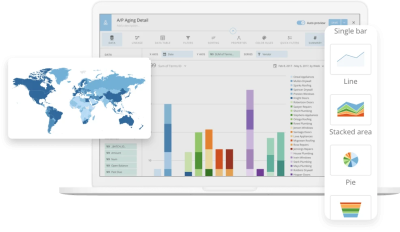How to create a successful mobile BI experience
In the past decade, the smartphone has revolutionized how people use the Internet and access information. Now, everyone walks around with a powerful computing device in their pocket. It’s becoming more and more common for people to completely drop desktops entirely and only use mobile devices for all their computing needs.
While desktops and laptops aren’t dying off just yet, all signs suggest that mobile computing will be the primary way most people interact with the Internet in the future. Mobile devices will be the most popular way to use the Internet and access information, even in business settings.
Business technology has adapted and changed to mobile computing effectively in some areas, but in others, it’s still stuck in the past. Even businesses that focus on mobile operations still often do their work on desktop workstations.
That needs to change. In today’s work environments, with remote and hybrid work making up such a large part of so many businesses’ operations, employees need to be able to access their data and do their work on mobile devices.

This is especially true in business intelligence, where users need constant access to their important dashboards and KPIs. Historically, business intelligence tools have been large, complex tools stored on-premise, and users needed powerful computers to perform data analytics.
With recent advances in the industry, that’s not the case. The most popular BI tools in the present aren’t anything like the old tools of the past. They’re cloud-based, agile, and user-friendly, allowing for greater flexibility in how and when users interact with them.
The core of this approach is mobile BI—mobile-friendly BI tools and apps that allow users to perform BI operations on mobile devices like smartphones and tablets.
However, businesses can’t just invest in a new BI tool and expect their mobile BI approach to transform overnight. Building a mobile BI strategy is work, and unless businesses take the time and effort to do it right, they won’t be able to translate their new tool into mobile value.
The advantages of mobile BI are clear—businesses that use mobile BI to communicate data and drive decisions can reach crucial business decisions much faster than businesses without it. However, without a clear guide on how to implement a mobile BI strategy, businesses won’t be able to access that value.
To effectively build a mobile BI strategy, businesses need to cut through all the hype, figure out mobile BI best practices, and implement their strategies in ways that users will actually enjoy.
How mobile BI is different
Most BI tools assume that the average user will be accessing the tool through a desktop or laptop; these methods are generally thought of as the ‘default’ data access experience.
Since BI tools assume that the people accessing them will be doing so through a computer, they can make other assumptions when they design their tool based on that. For instance, UI features are generally designed with a mouse and keyboard in mind.
When businesses start to implement a mobile BI strategy, they have to throw all those assumptions out. If mobile devices are going to be the default way that users access their data, then many features need to be designed in different ways.
Many BI vendors offer mobile apps where these differences have been taken under consideration. With features and visualizations designed for smartphone-scale viewscreens and touchscreen controls, these tools are much easier to use on a mobile device than BI desktop apps.
Some key differences, like the size and shape of the viewscreen and touchscreen controls, can be mitigated with these apps, but BI users and dashboard designers also need to do their part to design mobile-friendly dashboards and visualizations.
One additional issue that desktops don’t really have to worry about is the operating system. PCs and Macs may have their differences, but at least users can access the same web page through either OS.
On mobile devices, that’s not the case. The device’s OS affects what sort of apps it has access to, so it’s possible that Android users can’t access an app that Apple users can, or vice versa.
It’s a hard sell to tell all your employees to buy one kind of phone for work. It’s a much better idea to look for a BI vendor that offers both iOS and Android apps.

How does the cloud affect mobile BI?
Mobile devices don’t have the processing power or the storage space to run a BI tool on their own hardware. That doesn’t matter—most BI tools aren’t run on native, business-managed hardware anymore. BI tools have moved to the cloud, which is what makes mobile BI possible.
The ‘cloud’ is the term for third-party, decentralized data storage. With a cloud storage system, data isn’t stored on-premise on a specific computer hard drive or server. Instead, businesses pay third parties to store their data on remote servers that they can access through the Internet.
Almost every market-leading BI tool is primarily cloud-based. There are often options to still store data on-premise, but the advantages of cloud computing are so clear that most companies are happy to switch over.
This means that businesses don’t need to worry about hardware requirements or storage space when they want to implement a BI tool. Since none of the advanced calculations that a BI tool does are actually happening on your device, you don’t need a powerful computer to use a BI tool anymore.
In fact, hardware requirements for cloud-based BI tools are so low that basically any device with a screen and Internet access can run a BI tool. This innovation is what makes mobile BI possible.
That means that if a business wants to make mobile BI a priority, they absolutely have to invest in a BI system that’s cloud-based. Older, on-premise BI tools can’t provide that sort of flexibility. Businesses that use those sorts of tools are chained to their desktop workstations and physical storage.
How can I make mobile BI easier to use?
Even with BI apps that adapt BI tools for mobile use and with cloud-based solutions that allow users to perform data analysis without the hardware and storage to support it, the mobile BI experience is still often inferior to desktop BI.
Desktop BI is still the priority at many businesses, and that’s for good reason. Even though mobile computing has become a huge part of the tech industry, most employees still do most of their work using desktops and laptops.
Since they’re not the priority, mobile users often get ignored when it comes to dashboard design and other UI-related features. This is extremely frustrating, especially for dashboards that are intended to be viewed on the go or by remote workers.
How can businesses design their BI user experience to facilitate mobile BI success? There are a few elements that businesses need to stay aware of so that their mobile dashboards and visualizations are still effective when viewed on a mobile device.

For example, a detail as small as the different orientation of a viewscreen can dramatically change how users interact with BI content.
Desktops and laptops almost always have viewscreens that are wider than they are tall. That means there’s more space to the left and right than there is at the top and bottom. Since this is the default orientation for basically every computer ever made, dashboard designers generally design based on that.
In this orientation, visualizations tend to be wider, and dashboard designers often arrange their visualizations in wide rows. This helps desktop users see more visualizations at once and understand the data better.
Smartphones, though, have screens that are taller than they are wide. Screens are narrow, and they have more space at the top and bottom. This means dashboards and visualizations designed for desktops are hard to view and use on mobile.
Dashboards that wouldn’t have to scroll left or right on a desktop get cut off and are hard to see on a phone. In addition, phone screens are so small that it’s very hard to get any value out of more than one visualization at a time.
Dashboard designers that want to make the mobile experience easier can vertically align their dashboards and choose visualizations that track well on a smaller screen. This way, mobile users don’t have to fight their tools to get their data.
Touchscreens can also make using BI dashboards harder. Most dashboard UX assumes that users will be using a mouse and keyboard, or at least a trackpad, to navigate their dashboards.
Designers often rely on desktop-only functionality, like arrow keys and mouse clicks, to build their drill paths, filter their cards, and navigate their tool as a whole. These sorts of things don’t track well on smartphones and touchscreen-only controls.
When building out things like drill paths, which usually rely on mouse clicks to activate, businesses need to make sure that their control schemes are device-agnostic.
Mobile BI—leave the desktop behind
Mobile devices are the future of computing, and businesses need to plan ahead for that. In today’s markets, businesses need a mobile strategy so that users can access their data and make decisions from anywhere.
To make effective use of mobile BI, businesses need to design their dashboards and visualizations to be mobile-friendly. With mobile-friendly design, users can draw insight from anywhere, right from their phones.
Check out some related resources:

8 Best AI Tools for Data Visualization

Guide to ETL Data Modeling: Process, Techniques, and Best Practices






